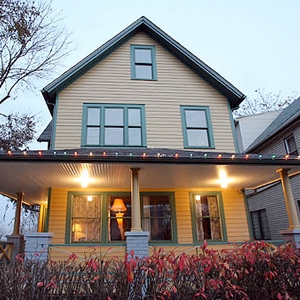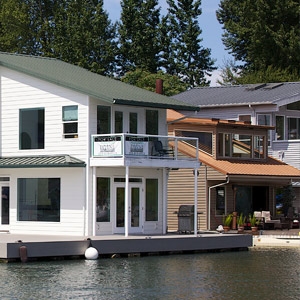More on Houseboat Floats
 This is a picture of a major float repair during construction. This house is quite large, and even though it is older and somewhat dated it is a premium floating home considering the locaton, size and style of the home. Once under contract for sale, the float inspection revealed that some major work needed to be done to the float. Two logs were missing and needed to be installed beneath the side decking (which you can see here). Animals had intruded into the duct work and insulation beneath the home, causing a lot of damage including opening up the heat ducts so that heating the house became difficult. Of course the racoons were toasty in their little cave beneath the floor. Although the stringers were not in bad shape, opening up the entire first floor of the home to do the other repairs made replacing the stringers with steep beams a costly but natural decision for a home of this size and cost.
This is a picture of a major float repair during construction. This house is quite large, and even though it is older and somewhat dated it is a premium floating home considering the locaton, size and style of the home. Once under contract for sale, the float inspection revealed that some major work needed to be done to the float. Two logs were missing and needed to be installed beneath the side decking (which you can see here). Animals had intruded into the duct work and insulation beneath the home, causing a lot of damage including opening up the heat ducts so that heating the house became difficult. Of course the racoons were toasty in their little cave beneath the floor. Although the stringers were not in bad shape, opening up the entire first floor of the home to do the other repairs made replacing the stringers with steep beams a costly but natural decision for a home of this size and cost.
The contractor opened the first floor inside the building, removing all flooring and kitchen appliances. He was able to leave the kitchen cabinets in place to work around them. While the floor was open, he installed all new steel stringer. This work is able to be done without opening the floor, but working on the ducts for the heating and AC system, plus adding 4 inches of solid insulation board, made opening the floor necessary. This work is very dangerous if done from the water. But, it can be done. As with all other floating home work, the floating home communities have their own set of companies who do the repairs and construction.
Once the floor was open, the contractor added the insulation. He inserted the steep stringers, and then removed the old wooden stringers. He ‘pinned’ the stringers to the logs and the house using large steel pins or screws that are made for that purpose. Pinning stablizes the float and the home. He added the two new logs, one of each side of the house. As you can see from the picture, the logs have been planed off on the top side to make a flat place for the stringers to rest and be pinned to. If you recall, these old logs only rot where they are exposed to air and that takes years. These logs should be good for at least 20 years before requiring any further work. If there is evidence of deterioration, the logs themselves can be repaired by removing the rot area and resurfacing that portion of the log with other materials.









Hello Karla….great website! My wife and I currently live on the Multnomah Channel in Scapppoose and are looking to refinance our home…currently owner carrying for another year….have lots of questions regarding financing and float survey….need some work on float but need more research first…..Thanks for any help…..I can be reached at 503-319-6149